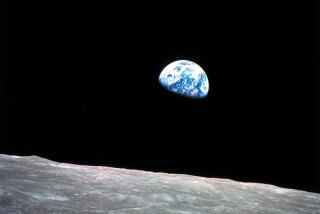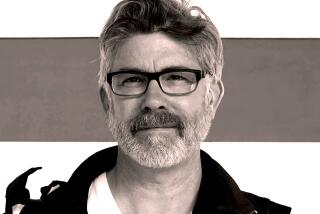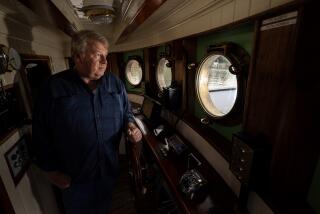It Was 60 Years Ago That the Lone Eagle Soared
LITTLE FALLS, Minn. — The two women sat on the porch of the turn-of-the-century frame home talking to each other about the importance of this small Minnesota farm center to one of America’s greatest folk heroes, Charles A. Lindbergh.
“My husband loved it here. He always looked forward to visiting Little Falls where he grew up and developed his love of aviation and the environment,” said Anne Morrow Lindbergh, 79, the famed pilot’s widow and author of a dozen books about her life, her times and her philosophy.
Seated beside her was her daughter, Reeve Lindbergh Tripp, 42, youngest of the Lindberghs’ five living children. Anne Morrow Lindbergh had come to Little Falls from her home in Darien, Conn., her daughter from her home in St. Johnsbury, Vt.
They had come to this town of 7,000 to mark the 60th anniversary of Charles Lindbergh’s epic 32 1/2-hour nonstop New York-to-Paris solo flight in his 27-foot-long, single-engine monoplane, the Spirit of St. Louis.
Last month in Paris, on May 20-21, the anniversary days of Lindbergh’s historic 1927 conquest of the Atlantic, commemorative observances were held including the reenactment of the Spirit of St. Louis’ landing at Le Bourget airfield and the unveiling and dedication at Charles de Gaulle Airport of sculptor Paul T. Granlund’s second casting of the two-figure bronze statue entitled “Lindbergh, the Boy and the Man.”
Granlund’s original casting was placed on the Minnesota capitol grounds in St. Paul in 1985. It captures the Lone Eagle in two stages of his life, as a boy at his Little Falls home wearing overalls with a slingshot in his pocket and his arms outstretched imitating flight, and as he was at 25 in his flying suit when he flew the Atlantic alone.
All the achievements of mankind have value only to the extent that they preserve and improve the quality of life.
--Charles Lindbergh
Ten years ago astronaut Neil Armstrong, Gen. James Doolittle and members of the Explorers Club established the Charles A. Lindbergh Fund to honor the memory of the flyer who died at the age of 72 in 1974. The fund’s goal is to further Lindbergh’s efforts to strengthen the balance between technological progress and the preservation of the environment.
Every year since, several $10,580 grants--each award representing the original cost of the Spirit of St. Louis--have been given to individuals whose research projects represent a significant contribution to this effort.
With the 10 recipients for 1987, a total of 84 scientists from throughout the nation and a dozen foreign countries have now received grants.
For the first time since the establishment of the fund, the grants--donations from individuals and corporations--were awarded this year in Little Falls at a three-day symposium, June 19-21, during which the 1987 and 34 past recipients participated in a public forum, “Exploring the Human Future.”
Several Addresses
Addressing the symposium were astronaut Rusty Schweickart; Paul B. MacCready, the father of human and solar powered flight; Dr. Richard Bing, a colleague of Lindbergh and director of cardiology and scientific development at the Huntington Medical Research Institute in Pasadena; and by Dr. Theodore Malinian, who spoke about Lindbergh’s contributions to biomedical research.
Charles Lindbergh’s grandfather spent 11 years as a member of the Swedish parliament, then migrated to Minnesota in 1859 and took up a homestead. The aviator’s father, a Little Falls attorney, represented this part of central Minnesota in the U.S. House of Representatives for 10 years. His mother was a chemistry teacher at Little Falls High School.
The Lindberghs had a 110-acre farm on the pine-covered banks of the Mississippi where as a teen-ager Charles milked cows and cared for sheep and chickens. In 1930, the family gave the farm to Minnesota and it has now been expanded to a 300-acre state park, including the Lindbergh home and the Lindbergh Interpretive Center administered by the Minnesota Historical Society.
“Members of our family are so moved by the house and its contents,” said Reeve Lindbergh Tripp. “Before my father died he arranged the exhibits in the house with his mother’s and father’s things; their furniture; the cot on the porch where my father loved to lay and look out at the stars on cold, wintry nights; his books; his toys; and in the basement, the well he constructed and the incubator he made for his chickens. They lived in the house without electricity or telephone.”
Reeve Tripp, vice president of the Lindbergh Fund, said her father lived in Little Falls until he was 18 and “kept coming back to his home town in the latter years of his life. He said he returned to his roots to refresh himself, to think about his philosophy and what his life meant to him.”
And she observed: “If you have a famous parent you share him with the whole world and when he dies the world gives him back to you. My father comes back in a wonderful way. That’s why we are here. . . . “
Screenings of Film
In the Interpretive Center, the classic film “The Spirit of St. Louis” starring Jimmy Stewart, is shown. There is a 1916 Saxon car Lindbergh and his mother drove to Redondo Beach, Calif., where they spent the winter of 1916-17 and where he attended Redondo Beach Union High School. The family returned to Little Falls and Charles graduated from Little Falls High School.
One wall in the center is covered with photographs of Lindbergh barnstorming as a wing walker and parachuter across the Midwest and South in a montage of photos he took of planes he crash-landed. There are books about Lindbergh including “The Spirit of St. Louis” he wrote in 1953 about his famous flight, a book that later won him a Pulitzer Prize.
Photos show him leaving New York in the Spirit of St. Louis, arriving in Paris and being mobbed by 100,000 frantic Frenchmen and his welcome home by President and Mrs. Calvin Coolidge and a crowd of 300,000 in New York. On display is a newspaper cartoon of the day depicting the Statue of Liberty jumping off its pedestal and top floors blowing off skyscrapers with the Spirit of St. Louis circling overhead.
Headlines on a copy of the Little Falls Daily Transcript for May 22, 1927 proclaimed: “Lindbergh Arrives in Paris. Little Falls Goes Wild as Favorite Son Lands Safely.”
Lindbergh Description
In the Interpretive Center, Lindbergh’s voice is heard telling his thoughts, describing his solo flight: “Here, all around me is the Atlantic, its expanse, its power, its wild and open water. . . . “
And in the wake of his historic hop, there are examples of Lindbergh dolls, sheet music with songs like “Lindy You Flew Into Everyone’s Heart,” Spirit of St. Louis five-cent cigars, Lucky Lindy hood ornaments for cars, Spirit of St. Louis airplane model kits, games and more.
“People who were old enough to remember the flight come into the Interpretive Center from all over the country, from all over the world, and tell us where they were and what they were doing when Charles Lindbergh flew the Atlantic,” noted Charles Stone, 62, a retired Air Force pilot and curator of the center the past 8 1/2 years.
Two months after his historic journey, Lindbergh was off on a 48-state odyssey flying the Spirit of St. Louis to promote aviation. The tour consumed 260 hours and 45 minutes of flying time and covered 22,000 miles. He made 82 stops and spent at least one night in each state. He was later to write:
“It let me know my country as no man had every known it before. I landed in every state in the union, inspected sites for airports. I tried to convince everyone who would listen that aviation had a brilliant future.”
Back in the Air
On Dec. 13, 1927, he took off again for two months of flying to Mexico City, Central and South America and the Caribbean in the Spirit of St. Louis. On April 30, 1928, he gave the plane to the Smithsonian where it has been ever since.
It was in Mexico City that he first met Anne Morrow, daughter of Dwight Morrow, the U.S. ambassador to Mexico. Anne Morrow and Charles Lindbergh were married in 1929.
Anne Morrow Lindbergh joined her husband as an aviation pioneer. She was the first licensed woman glider pilot in the United States. She was co-pilot, navigator and radio operator on 40,000 miles of exploratory flying with her husband in 1931 and 1933 over five continents.
They flew a Sirius, a two-place, 600-horsepower Cyclone engine plane with pontoons, named after the brightest star in the sky, flying over much of the Earth where no airplane had ever flown before, never knowing where they were going to land. Commercial airlines still use routes pioneered by them.
More to Read
Sign up for Essential California
The most important California stories and recommendations in your inbox every morning.
You may occasionally receive promotional content from the Los Angeles Times.










